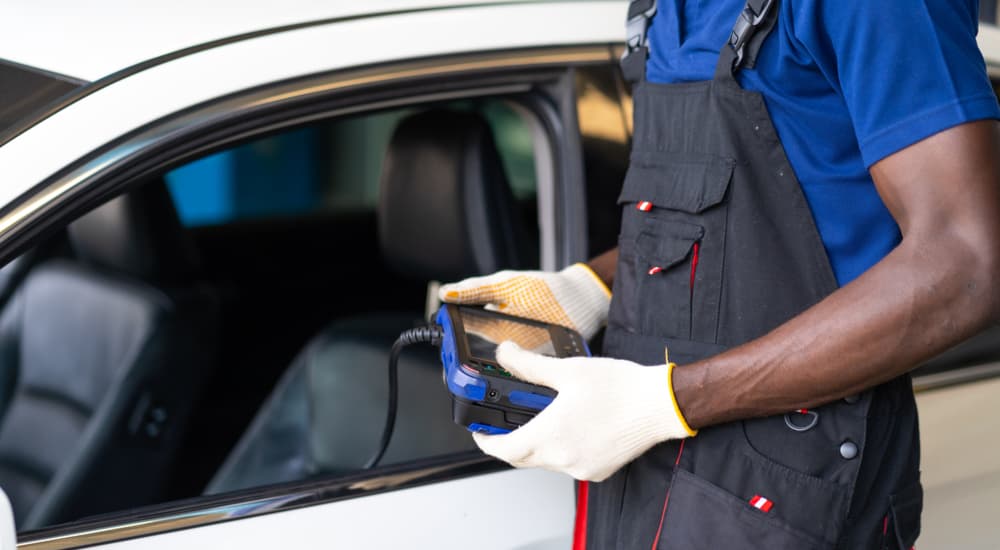You are ready to get behind the wheel of a new vehicle. But before that can happen, you need to get rid of your current model. Whether you sell it privately or use it as a trade-in toward your next vehicle is entirely up to you. Either way, you will need to know what your car is worth. There are plenty of “value my car” tools out there, but how is that value calculated?
The value of your car is not some random price you post on an advertisement or negotiate with a dealership; there’s far more to it than that. Ironically, though, there isn’t an exact value for any vehicle – not yours, your neighbor’s, or anyone else’s. There’s no guidebook that outlines what every vehicle is worth because there are too many variables to consider like age, mileage, condition, trims, packages, etc.
It may seem that the idea of valuing your vehicle just became a little more complex. Fortunately, determining the value of your car isn’t all that difficult. Here’s a quick overview of how car values are determined as well as a few key things you can do to maximize that value to get the most for your car, truck, or SUV.
Determining Value: It Depends on Who You Ask
As we mentioned, there isn’t a set value for any vehicle and that makes valuing your vehicle more subjective. Essentially, it comes down to who you ask or where you look. Take Kelley Blue Book and Edmunds as examples; both are well-established resources that make valuing vehicles as easy as inputting a few details in their websites and letting their proprietary systems do the work. The results, however, won’t always match.

History of Vehicle Valuation Tools
Established in the late 1920s, Kelley Blue Book got its start as a valuation service for insurance companies and banks who needed a reliable way to value used vehicles. Since then, Kelley Blue Book has become a dependable source used by individuals and dealerships alike.
Edmunds has a younger, albeit, similar history with its origins dating to the mid-1960s when the company was founded to assist buyers by publishing new and used automotive prices. Like Kelley Blue Book, the company evolved to meet the demands of the industry by giving drivers an array of tools designed to engineer confidence when buying and selling any new or used vehicle.
The Kelley Blue Book Value
While there may not be an official guidebook of car values, Kelley Blue Book is as close as it gets. The company gathers data from automotive sales conducted at wholesale auctions and by dealerships. This data gives the company a baseline of a vehicle’s value and serves as a starting point for further research. From there, the organization examines the current economy, historical trends, location, season, and developments in the industry to determine the Blue Book Value for the model in question.
When you turn to Kelley Blue Book to value your vehicle, you’ll find many other factors about the vehicle itself are also taken into consideration. For starters, some vehicles are in greater demand than others and that reflects their higher value despite their age or, in other words, a slower rate of depreciation. Models like the Toyota Tacoma and Jeep Wrangler are prime examples of this as the models are in high demand among drivers who want the adventurous spirit of the Wrangler and the reliability of the Toyota name.
Your location and everything from the body style of your vehicle to its engine and features plays an important role in determining its value. Convertibles are extremely valuable in coastal areas with warm climates but have a much lower value in areas with colder temperatures. Trucks with beefier engines typically fetch a higher price as do four-wheel-drive vehicles, especially if you’re in a mountainous area or a region with harsh weather conditions and rugged terrain.
By considering these factors, Kelley Blue Book determines the value of your car. Every search gives you three unique values that you can use to your benefit. The Kelley Blue Book Trade-In Value is what you can expect to get when trading in the vehicle and the Kelley Blue Book Private Party Value is what you can expect to get or pay when buying or selling privately. The Kelly Blue Book Suggested Retail Value is, perhaps, the most important for many as this value is a great starting point for negotiating a final price.
Fair Purchase Price: What’s the Difference?
The value of your car isn’t the same as what’s known in the industry as the “fair purchase price.” Why does this matter? The fair purchase price is what people are paying for the vehicle, which might not always measure up to what it’s worth. This is where your location and the type of vehicle come into play.
Let’s say that you’re in the heart of rural Texas where trucks like the Chevy Silverado HD rule the road. Your Mustang convertible is instantly recognizable in the flat Texas landscape and isn’t all that attractive to potential buyers who don’t have much use for anything beyond a workhorse like the Chevy. While your convertible may be valued at $15,000, its fair purchase price for Texas will likely be much lower. In a coastal town in Florida, however, your convertible’s fair purchase price will come closer to its actual value.

Maximizing Your Car’s Value
Whether you’re selling your car privately or trading it in for a newer model at your local dealership, it’s important to make a good first impression. This means taking the time to clean your car inside and out or spending a little extra money to have it professionally detailed. Professional detailers are skilled at bringing out the best in vehicles and can get your car as close to its original condition as possible. They know all the tricks to remove stubborn stains from the upholstery and can resolve other minor issues caused by normal wear and tear.
Cosmetic issues like broken lights and a cracked windshield are inexpensive fixes as is adding new floor mats to give the interior an updated and clean look. Along with these obvious issues and easy fixes, you can proactively maximize the value of your car by being a responsible owner. This means overseeing its routine maintenance and taking care of any necessary repairs that, if ignored, are not only detrimental to your safety but make the vehicle difficult, if not impossible, to sell.
What’s Your Car Worth?
Buying a new vehicle is an exciting process that, believe it or not, starts long before you visit the dealership. It starts with knowing what your current vehicle is worth. The value of your car sets the tone for the entire car-buying process because it tells you how much cash you’ll have in hand to put toward your next purchase.
While there’s no official guidebook that clearly states the value of every car ever made, sites like Kelley Blue Book and Edmunds certainly come close. They give you the tools and information you need to value your car and take the next step in your journey as a car owner. While the values may vary from one site to another, the figures give you a starting point for negotiation and, as you’re well aware, that’s the spirit of the entire car-buying and selling process.



